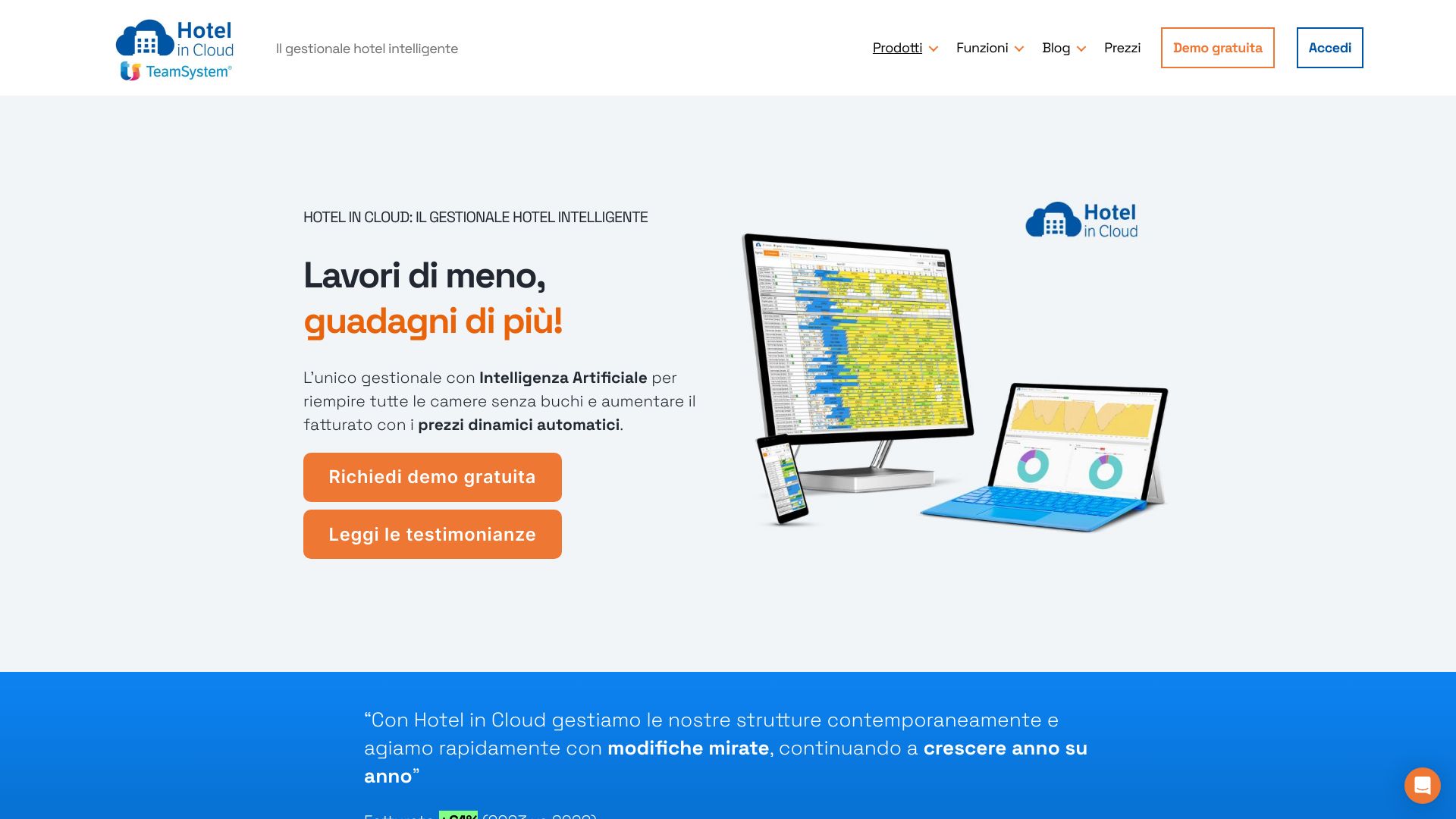
Hotel in Cloud
Open Website-
Tool Introduction:All-in-one hotel PMS, booking, channels & AI revenue with dynamic pricing.
-
Inclusion Date:Oct 28, 2025
-
Social Media & Email:
Tool Information
What is Hotel in Cloud AI
Hotel in Cloud AI is an all-in-one, intelligent hotel management software that unifies a Property Management System (PMS), Booking Engine, Channel Manager, and AI-powered Revenue Management System (RMS). It centralizes reservations, rates, and availability, automates distribution across OTAs, and applies dynamic pricing to lift RevPAR and occupancy while protecting rate parity. With real-time dashboards, configurable rules, and automation, it helps teams reduce manual work, minimize overbookings, and make faster data-driven decisions from a single, secure cloud platform.
Hotel in Cloud AI Key Features
- Unified PMS: Manage reservations, check-in/out, folios, and room status in one property management system to streamline front-office workflows.
- AI-driven RMS: Use dynamic pricing and demand signals to adjust rates automatically within your guardrails to optimize occupancy and ADR.
- Direct Booking Engine: Offer a mobile-friendly, branded booking flow to capture commission-free direct bookings and upsell add-ons or packages.
- Channel Manager: Sync inventory, rates, and restrictions across major OTAs with two-way updates to reduce overbookings and maintain parity.
- Rate and Inventory Controls: Set floors/ceilings, stop-sell, length-of-stay, and close-to-arrival rules based on occupancy or pacing.
- Automation: Trigger last-minute discounts, early-bird offers, or auto-open/close rates according to demand thresholds.
- Reporting and Analytics: Track pick-up, occupancy, ADR, RevPAR, and channel mix to inform revenue decisions and forecasting.
- User Roles and Permissions: Assign access by team role to protect data and streamline approval workflows.
- Cloud-native Reliability: Access anywhere with updates delivered in the cloud for security and scalability.
- Integrations: Connect with common hotel tech (payments, website CMS, accounting) to keep data in sync across your stack.
Who Should Use Hotel in Cloud AI
Hotel in Cloud AI is suited for independent hotels, boutique properties, hostels, serviced apartments, and resorts seeking to centralize operations, automate distribution, and improve revenue performance. It supports general managers, revenue managers, owners, and front-desk teams who need a single platform to manage reservations, pricing, and channels while boosting direct bookings and reducing manual rate updates.
How to Use Hotel in Cloud AI
- Create your account and property profile, including rooms, room types, taxes, policies, and amenities.
- Configure rate plans and restrictions, then import existing reservations or sync them from your current system.
- Connect the booking engine to your website and set up payment and cancellation policies.
- Link OTA channels via the Channel Manager and map room types and rate plans for two-way synchronization.
- Define your pricing strategy and guardrails in the RMS (rate floors/ceilings, occupancy triggers, segmentation rules).
- Enable automation for dynamic pricing and distribution updates, starting with supervised approvals if needed.
- Set user roles and train staff on daily workflows in the PMS, reports, and dashboards.
- Monitor performance (pick-up, ADR, RevPAR) and iterate rules as demand patterns change.
Hotel in Cloud AI Industry Use Cases
A boutique city hotel uses AI-driven pricing to capture late-booking demand on weekdays while protecting corporate rate fences. A seasonal beach resort automates close-to-arrival rules and package upsells in the booking engine to smooth shoulder periods. A hostel or serviced apartment operator relies on the Channel Manager to maintain rate parity and avoid overbookings across high-traffic OTAs during peak season.
Hotel in Cloud AI Pros and Cons
Pros:
- All-in-one platform reduces vendor sprawl and data silos.
- Dynamic pricing helps grow RevPAR and occupancy without constant manual updates.
- Two-way channel sync minimizes overbookings and streamlines distribution.
- Direct booking engine supports lower acquisition costs and better brand control.
- Clear analytics guides decisions on pricing, inventory, and channel mix.
- Cloud access, security, and ongoing updates support scalability.
- Role-based controls improve governance and operational consistency.
Cons:
- Requires initial setup and training for pricing rules, mappings, and workflows.
- AI recommendations still benefit from human oversight during special events or anomalies.
- Data quality and channel connectivity directly impact results.
- Legacy integrations or process changes may need extra implementation effort.
- Feature availability and channel coverage can vary by market; verification is advisable.
Hotel in Cloud AI FAQs
-
Question 1: How does dynamic pricing work in Hotel in Cloud AI?
The RMS adjusts rates based on demand signals and occupancy targets within your predefined guardrails, helping balance ADR, occupancy, and parity across channels.
-
Question 2: Can I use the booking engine and OTAs at the same time?
Yes. Inventory and rates are centralized, so direct bookings and OTA sales draw from the same pool, with two-way updates to avoid double-booking.
-
Question 3: What KPIs should I track to measure impact?
Monitor pick-up, occupancy, ADR, RevPAR, cancellation rate, and channel mix to evaluate pricing, distribution, and direct booking performance.
-
Question 4: Do I lose control over pricing with AI?
No. You can define floors, ceilings, and rules, and start with supervised approvals before enabling more automation.
-
Question 5: How do I prevent rate parity issues?
Use consistent rate plans, apply restrictions uniformly via the Channel Manager, and set RMS guardrails to avoid undercutting your own direct rates.
